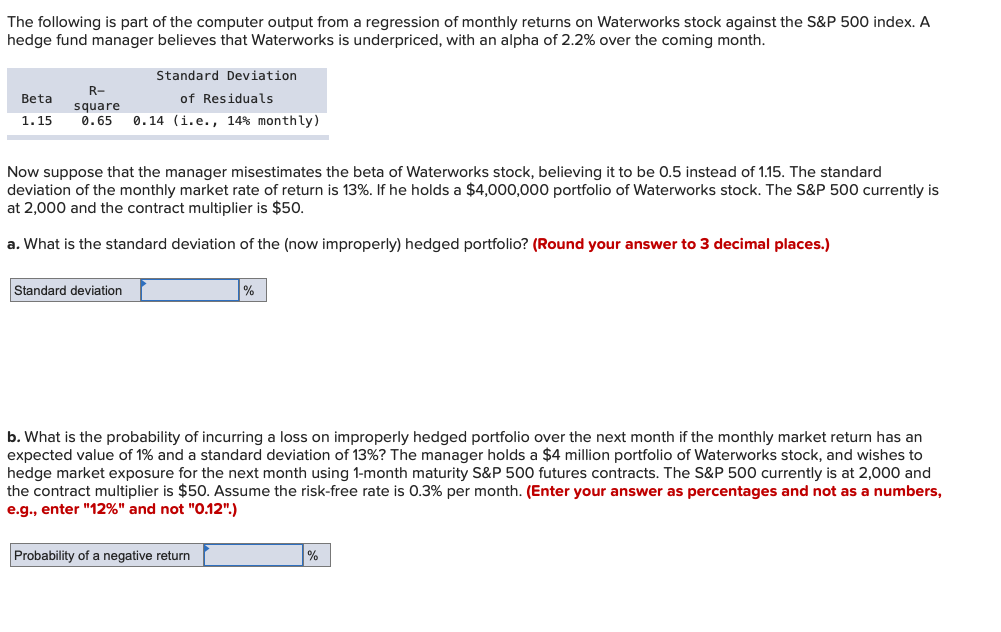

The following is part of the computer output from a regression of monthly returns on Waterworks stock against the S&P 500 index. A hedge fund manager believes that Waterworks is underpriced, with an alpha of 2.2% over the coming month. Beta R- square 0.65 Standard Deviation of Residuals 0.14 (i.e., 14% monthly) 1.15 Now suppose that the manager misestimates the beta of Waterworks stock, believing it to be 0.5 instead of 1.15. The standard deviation of the monthly market rate of return is 13%. If he holds a $4,000,000 portfolio of Waterworks stock. The S&P 500 currently is at 2,000 and the contract multiplier is $50. a. What is the standard deviation of the (now improperly) hedged portfolio? (Round your answer to 3 decimal places.) Standard deviation % b. What is the probability of incurring a loss on improperly hedged portfolio over the next month if the monthly market return has an expected value of 1% and a standard deviation of 13%? The manager holds a $4 million portfolio of Waterworks stock, and wishes to hedge market exposure for the next month using 1-month maturity S&P 500 futures contracts. The S&P 500 currently is at 2,000 and the contract multiplier is $50. Assume the risk-free rate is 0.3% per month. (Enter your answer as percentages and not as a numbers, e.g., enter "12%" and not "0.12".) Probability of a negative return 1% c. What would be the probability of a loss if you hold an equally weighted portfolio of 100 stocks with the same alpha, beta, and residual standard deviation as Waterworks and the manager similarly misestimated beta as 0.5 instead of 1.15? The manager holds a $4 million portfolio of Waterworks stock, and wishes to hedge market exposure for the next month using 1-month maturity S&P 500 futures contracts. The S&P 500 currently is at 2,000 and the contract multiplier is $50. Assume the risk-free rate is 0.3% per month. (Round your answer to 2 decimal places. Enter your answer as percentages and not as a numbers. (Eg: Enter "12%" and not "0.12".)) Probability of a negative return % The following is part of the computer output from a regression of monthly returns on Waterworks stock against the S&P 500 index. A hedge fund manager believes that Waterworks is underpriced, with an alpha of 2.2% over the coming month. Beta R- square 0.65 Standard Deviation of Residuals 0.14 (i.e., 14% monthly) 1.15 Now suppose that the manager misestimates the beta of Waterworks stock, believing it to be 0.5 instead of 1.15. The standard deviation of the monthly market rate of return is 13%. If he holds a $4,000,000 portfolio of Waterworks stock. The S&P 500 currently is at 2,000 and the contract multiplier is $50. a. What is the standard deviation of the (now improperly) hedged portfolio? (Round your answer to 3 decimal places.) Standard deviation % b. What is the probability of incurring a loss on improperly hedged portfolio over the next month if the monthly market return has an expected value of 1% and a standard deviation of 13%? The manager holds a $4 million portfolio of Waterworks stock, and wishes to hedge market exposure for the next month using 1-month maturity S&P 500 futures contracts. The S&P 500 currently is at 2,000 and the contract multiplier is $50. Assume the risk-free rate is 0.3% per month. (Enter your answer as percentages and not as a numbers, e.g., enter "12%" and not "0.12".) Probability of a negative return 1% c. What would be the probability of a loss if you hold an equally weighted portfolio of 100 stocks with the same alpha, beta, and residual standard deviation as Waterworks and the manager similarly misestimated beta as 0.5 instead of 1.15? The manager holds a $4 million portfolio of Waterworks stock, and wishes to hedge market exposure for the next month using 1-month maturity S&P 500 futures contracts. The S&P 500 currently is at 2,000 and the contract multiplier is $50. Assume the risk-free rate is 0.3% per month. (Round your answer to 2 decimal places. Enter your answer as percentages and not as a numbers. (Eg: Enter "12%" and not "0.12".)) Probability of a negative return %








